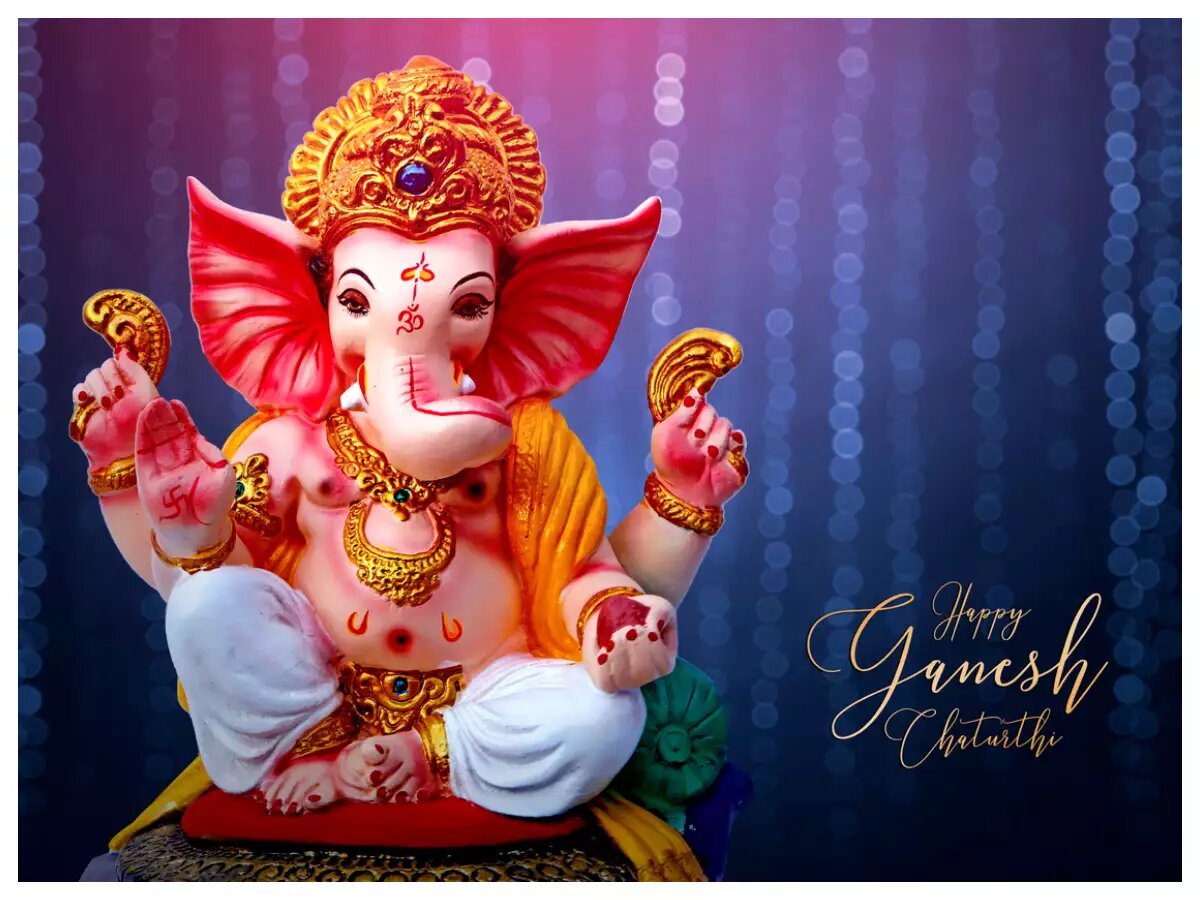Ganesh Chaturthi, also known as Vinayaka Chaturthi, is a Hindu festival that celebrates the birth of Lord Ganesha, the elephant-headed deity revered as the god of wisdom, prosperity, and good fortune. The festival usually falls in the Hindu month of Bhadrapada (August or September) and lasts for a period of 10 days.
During Ganesh Chaturthi, elaborate and colorful idols of Lord Ganesha are crafted and installed in homes, temples, and public places. The idols are typically made from clay, plaster of Paris, or other eco-friendly materials. The festival involves various rituals and ceremonies, including the prana pratishta (installation of life force) of the idol, offering prayers, performing aarti (a way of waving lamps), and making offerings of sweets, fruits, and other traditional delicacies.
The highlight of Ganesh Chaturthi is the immersion ceremony, also known as Visarjan, which marks the festival’s conclusion. On the last day, the idols of Lord Ganesha are paraded through the streets in grand processions, accompanied by music and dancing. The idols are then immersed in water bodies, such as rivers, lakes, or the ocean, with the belief that Lord Ganesha returns to his divine abode after bestowing blessings upon his devotees.
Ganesh Chaturthi is celebrated with great enthusiasm and fervor across various parts of India, especially in the states of Maharashtra, Gujarat, Karnataka, and Andhra Pradesh. In recent years, efforts have been made to promote eco-friendly celebrations by using biodegradable materials for idol making and avoiding the pollution caused by immersion of non-biodegradable idols in water bodies.
The festival not only holds religious significance but also serves as a cultural event that brings communities together to celebrate and seek blessings for success, prosperity, and new beginnings.
History of Ganesha and Ganesh Festival
The history of Lord Ganesha and the Ganesh Chaturthi festival is rooted in Hindu mythology and traditions. Here’s a brief overview:
History of Lord Ganesha:
According to Hindu mythology, Lord Ganesha is the son of Lord Shiva (one of the principal deities of Hinduism) and Goddess Parvati. The story of Ganesha’s birth varies in different texts, but a common version is as follows:
Goddess Parvati, wanting a protector and guardian, created Ganesha out of clay and brought him to life. She placed him at the entrance of her abode to guard against anyone entering while she bathed. When Lord Shiva returned home and tried to enter, Ganesha, following his mother’s orders, blocked his way. This led to a confrontation between Shiva and Ganesha, resulting in Shiva beheading Ganesha in anger.
Upon seeing her son’s fate, Goddess Parvati was filled with grief and anger. In order to pacify her, and to rectify the situation, Lord Shiva promised to bring Ganesha back to life. He ordered his followers to bring the head of the first living being they found, which happened to be an elephant. Shiva then attached the elephant’s head to Ganesha’s body, restoring his life and giving him his distinctive elephant-headed appearance.
Ganesha is revered as the remover of obstacles, the god of wisdom, and the patron of arts and sciences. He is often invoked at the beginning of important endeavors and is worshiped by Hindus before they start any new venture.
History of Ganesh Chaturthi:
The origin of the Ganesh Chaturthi festival dates back to the Maratha ruler, Chhatrapati Shivaji, who encouraged the celebration of the festival during the 17th century. However, it gained significant prominence during the 19th century when the freedom fighter Lokmanya Tilak used it as a platform to unite people against British colonial rule.
Lokmanya Tilak recognized the festival’s potential as a means of fostering unity and nationalistic spirit among the Indian population. He encouraged public celebrations and processions of Ganesha idols to counter the ban on public gatherings imposed by the British authorities. The festival became a way for people to express their cultural and religious identity while also fostering a sense of unity and resistance.
Today, Ganesh Chaturthi is celebrated with grandeur and enthusiasm across various parts of India. The festival has also transcended regional boundaries and is observed by Hindus worldwide. In addition to its religious significance, the Ganesh Chaturthi festival has cultural and social dimensions, bringing communities together and promoting eco-friendly practices in recent times.
Ganesh festival
Certainly, Ganesh Chaturthi is a Hindu festival that specifically celebrates the birth of Lord Ganesha. Here’s some more detailed information about the Ganesh festival:
Name: Ganesh Chaturthi (also known as Vinayaka Chaturthi)
Date: The festival falls on the fourth day of the waxing moon period in the Hindu month of Bhadrapada, which usually falls between August and September.
Duration: The festival typically lasts for 10 days, culminating in the grand immersion of Ganesha idols in water bodies.
Significance: Ganesh Chaturthi honors Lord Ganesha, who is considered the remover of obstacles, the god of wisdom, prosperity, and new beginnings. Devotees seek his blessings before starting any new venture or important life event.
Celebrations:
Idol Installation: Elaborate and artistically crafted idols of Lord Ganesha are installed in homes, temples, and public places. These idols are often made from clay, eco-friendly materials, or other substances.
Prana Pratishta: The idols are consecrated and brought to life through rituals known as prana pratishta, infusing the divine presence into the idol.
Worship: Devotees offer prayers, flowers, incense, and traditional sweets to Lord Ganesha. They perform aarti (a ritual of waving lamps) and sing devotional songs.
Modak Offering: Modak, a sweet dumpling considered to be Lord Ganesha’s favorite, is offered to him as a symbol of devotion.
Processions: Colorful processions carrying Ganesha idols through the streets are a common sight during the festival. These processions are accompanied by music, dancing, and chanting.
Visarjan: The festival concludes with the immersion (Visarjan) of Ganesha idols in water bodies, symbolizing his return to his divine abode. The immersion procession is vibrant and lively, with much fanfare.
Eco-Friendly Initiatives: In recent years, there has been a growing emphasis on celebrating Ganesh Chaturthi in an environmentally friendly manner. This includes using biodegradable materials for idol making and reducing pollution caused by the immersion of non-biodegradable idols.
Regional Variations: While Ganesh Chaturthi is celebrated throughout India, it holds special significance in the state of Maharashtra, especially in Mumbai, where large public processions and elaborate decorations are common.
Ganesh Chaturthi is not only a religious event but also a cultural phenomenon that brings communities together, fosters a sense of unity and allows people to express their devotion and creativity. It showcases the rich tapestry of Hindu traditions and has become a prominent festival in India and among Hindu communities worldwide.
Nicknames of Ganesha:
Lord Ganesha is often affectionately referred to by various nicknames and titles in Hindu mythology and popular culture. Some of these include:
Ganapati, Vinayaka, Vighneshvara, Gajanana, Ekadanta, Lambodara, Siddhi Vinayaka, Dhumraketu, Modakapriya, Sumukha, Bhalachandra, Gajakarna, Vakratunda, Mangalamurti, Modakapriya, Sarveshvara, Vighnaharta, Avighna, Chaturbhuj, Umaputra, Prathamesh, Siddhidata, Siddhivinayaka, Buddhinath, and etc.




